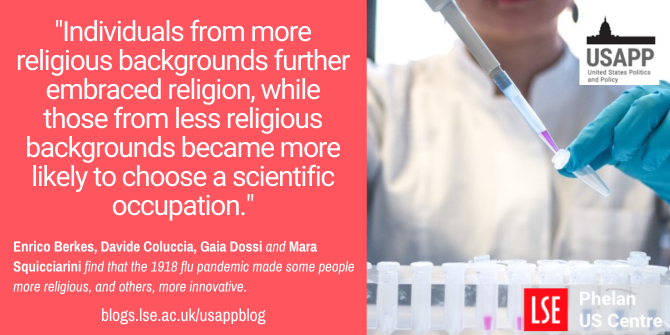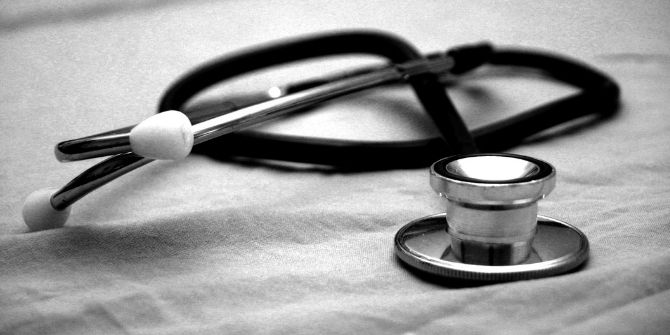


 What does adversity mean for people’s religious beliefs and for scientific progress? Enrico Berkes, Davide Coluccia, Gaia Dossi and Mara Squicciarini investigate whether a destructive event – such as a pandemic – leads to either an increase in religiosity or a boost in innovation efforts. They find that both reactions can occur at the same time, and that people in countries more affected by the 1918 flu pandemic become both more religious and more innovative.
What does adversity mean for people’s religious beliefs and for scientific progress? Enrico Berkes, Davide Coluccia, Gaia Dossi and Mara Squicciarini investigate whether a destructive event – such as a pandemic – leads to either an increase in religiosity or a boost in innovation efforts. They find that both reactions can occur at the same time, and that people in countries more affected by the 1918 flu pandemic become both more religious and more innovative.
Adverse events such as natural disasters and pandemics have always posed challenges to societies worldwide and continue to do so today. The recent COVID-19 pandemic, for example, has claimed almost seven million lives worldwide. Understanding how individuals cope with adverse events has key social, economic, and political implications, and it is crucial in designing effective policies in their aftermath.
There is evidence that shows how adverse events can make people more likely to be more religious. Separate research finds an increase in innovation efforts to mitigate the negative impact of, for example, environmental catastrophes. Can societies therefore become simultaneously more religious and more innovative? This would be surprising because religiosity and science are two phenomena that are typically in contrast with each other, both historically and today. In new research, we address this question by studying the reaction of religion and science to a catastrophic historical event: the 1918 Influenza Pandemic in the United States. The pandemic (also known as “Spanish Flu”) was one of the most lethal in modern history, killing around 0.7 percent of the US population in two years, a mortality rate more than twice as high as that of COVID-19. Historical records document that many people turned to or strengthened their religious faith in response to the 1918 pandemic. At the same time, the period that followed saw an increase in innovative activity and important medical advances. Despite being largely ineffective during the pandemic, medicine evolved enormously in subsequent years. By the 1930s, virology had become an established field in medicine and the development of the first influenza vaccines began.
Using baby names to measure religiosity following the 1918 Influenza Pandemic
To conduct our analysis, we developed a novel measure of religiosity based on how babies were named between 1900 and 1930 from historical full-count censuses. The key advantage of this approach is that it allows us to measure religiosity at a granular spatial level and yearly frequency. The underlying idea is that the first name given to a child conveys information on the religiosity of their parents. For example, with our approach we find that names associated with popular saints or biblical episodes such as “Esther” and “Paul” are associated with high religiosity. We then aggregate the measure at the county level. To measure scientific progress, we use the number of patents produced in a certain county, as well as the share of individuals in scientific occupations. Historical and modern accounts suggest that the pandemic hit the US in a near-random fashion. In the data we find support for this claim, and we further document that counties differentially hit by the Influenza pandemic were similar in terms of their religiosity, their production of innovation, and the share of individuals in scientific occupations before the pandemic.
Our results suggest that counties hit harder by the shock experienced an increase in religiosity. We also find that these same counties experienced an increase in innovative activities, and more specifically concentrated in pharmaceutical patents. In addition, we find that employment in scientific occupations grew in counties hit harder by the pandemic. Cities display a similar pattern: those which experienced higher excess deaths due to the pandemic became both more religious and more innovative.

Photo by Julia Koblitz on Unsplash
The 1918 pandemic made some people more religious and others, more innovative.
Did the same individuals become both more religious and more innovative after the pandemic or did different individuals react in different ways? We find evidence that the second mechanism is at play. Individuals from more religious backgrounds further embraced religion, while those from less religious backgrounds became more likely to choose a scientific occupation. These results suggest that, within counties, a group of individuals turned to religion as a coping device, while a separate group turned to science.
Our findings on religiosity are in line with two possible explanations. On the one hand, religious faith can provide a coping device to deal with personal distress following a negative shock (in the psychology literature, this is known as the “religious coping hypothesis”). On the other hand, individuals may turn to religion as a source of social insurance. While we are not able to fully distinguish between the two mechanisms, we interpret our evidence as being in favour of the religious coping hypothesis for two reasons. First, this interpretation of the results is in line with the literature showing that intrinsic religiosity—rather than churchgoing—responds to unexpected negative events. Second, the increase in religiosity persists for up to a decade after the shock, suggesting a change in behavior rather than a temporary need for social insurance.
What motivates people to turn to science is less obvious. Individuals may turn to science to deal with their psychological distress—similarly to religious coping—or to actively mitigate the negative effects of the pandemic. In support of this interpretation, we find that the increase in innovation is driven by individual inventors (the so-called “garage inventors”), rather than inventors within a firm or an organization. Additionally, we find that those turning to science are mostly young individuals, who experienced the pandemic in their late teens and early twenties. According to theories in psychology, these are the “impressionable years” when individuals form their preferences. Another possibility is that individuals turn to science because of increased labour demand in scientific occupations in counties more hit by the pandemic. While we cannot rule this out, our results suggest that, beyond market forces, the individual’s religious background (or, more precisely, the lack thereof) plays a key role in the decision to turn to science.
Despite the differences between the present context and the Influenza pandemic, including medical advancements over the past century, our research suggests that the response of modern society to COVID-19 (an increase in religiosity and innovation) is like that observed in 1918-1919. Our findings can help explain the opposing views that have emerged since the COVID-19 pandemic on science-based responses to the shock, such as the polarized attitudes toward vaccines.
- This article is based on Programme on Innovation and Diffusion (POID) Working Paper no. 68 Dealing with adversity: Religiosity or science? Evidence from the great influenza pandemic
- Please read our comments policy before commenting.
- Note: This article gives the views of the author, and not the position of USAPP – American Politics and Policy, nor the London School of Economics.
- Shortened URL for this post: https://bit.ly/3Wyp3vP





